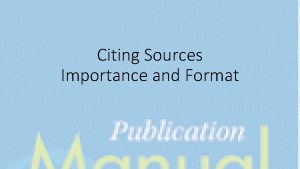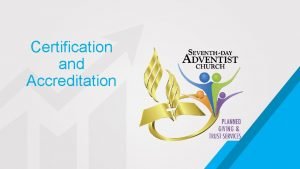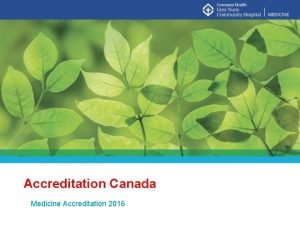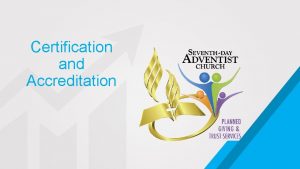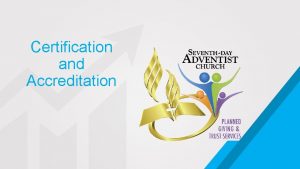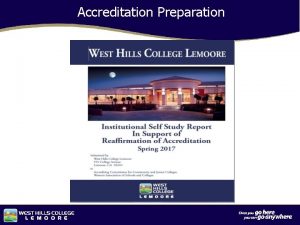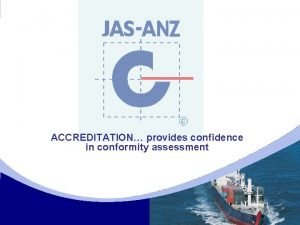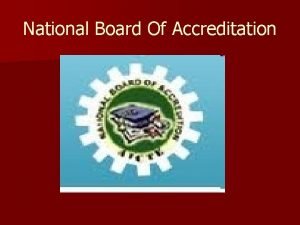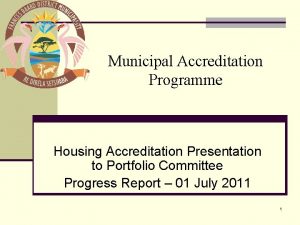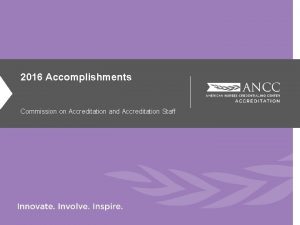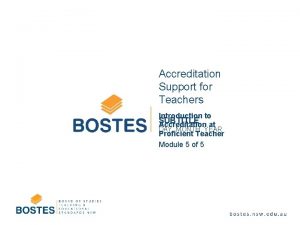Evidence in Accreditation The Importance of Evidence will












- Slides: 12

Evidence in Accreditation

The Importance of Evidence will be reviewed by team of peer evaluators Evidence supports the institutions claim that it meets or exceeds a standard Evidence can be presented in a variety of formats (tables, charts, graphs, samples of student work, SLO assessment results etc. ) Evidence consists of various data that has been collected analyzed during the preceding 6 years preceding the self evaluation year. Evidence must clearly demonstrate that a Standard is being met. The Evaluation teams and the Commission carefully review the evidence and will base their conclusions on their findings as supported by the evidence presented.

The Importance of Evidence Accurate and Up-to-Date Consistently used in the planning and implementation of improvements to the overall institution and its programs and services. From reliable Sources Longitudinal and Disaggregated by subpopulations of students as deemed appropriate Shared and Discussed among relevant parties within the institution so that all directly responsible for student progress toward attaining student learning outcomes and achieving educational goals may use the evidence to plan and implement any needed improvements.

Where can evidence be collected? 1. Program Review 5. Budget Committee 9. Student Focus Groups 2. Institutional Effectiveness 6. Guided Pathways Committees 10. CE Committees 3. Planning Councils 7. Equity Plans 4. Academic Senate Minutes 8. Event Flyers

Other possible sources of Evidence Institutional databases and fact books Catalogs Planning documents and program reviews Faculty/student handbooks Policy statements Minutes of important meetings Course outlines and syllabi Survey results Faculty grading rubrics and assessment of SLO’s Special research projects and reports

What type of evidence can be gathered from Guided Pathways/Redesign work ? 1. Initial Guided Pathways Plan (approved by Senate) 2. Scale of Adoption Assessment (approved by Senate) 3. Mapping day documentation 4. Sorting day documentation 5. “Area of Interest” or “Metamajor” organization 6. Enrollment management committee work 7. Institutional Effectiveness Goal Setting 8. Curriculum Development (minutes of Curriculum Committee) 9. Professional Development Activities 10. Student Focus Groups 11. Action and Implementation Plans 12. Program Review Documents

What evidence can be used to demonstrate your college’s commitment to equity? : • College Equity Plan • Disaggregated Student Success/Completion/Retention Data • Action plans that demonstrate the practice of equity at the District Planning level • College Mission, and College Strategic Goals and Objectives • Professional Development Opportunities for Faculty and Staff • Equitable Hiring Processes and revised EEO Plans • Senate/Guided Pathways/District Committees that focus on the practice of equity • Curriculum development and revision that is grounded in the practice of equity • Opportunities for student agency, participation, and learning through the planning process development of Guided Pathways • Reassessment of Program Review to incorporate measurement of new plans and structures • Commitment to Equitable onboarding processes • SEA Plans and Budgets

How much is too much or too little evidence? 1. Balance between data and narrative 2. Let the evidence drive the narrative 3. Qualitative and Quantitative Evidence 4. Evidence demonstrating the collaborative process of shared governance

Other possible sources of evidence can be found in the ACCJC resource Guide to Institutional Self-Evaluation, Improvement, and Peer Review (ed. 2020). Guide to Understanding and applying standards can be found on page 33 Possible sources of evidence follow each standard These lists are non-exhaustive Lists are not intended to indicate documents that must be referenced, only possibilities Examples are meant to guide toward evidentiary documents that the institution actually has Evidence will be relevant to the institutions unique mission, culture, and methods of operation

EXAMPLE FROM ISER


“When presenting evidence in the ISER, the institution does not need to present every available evidence document imaginable. Institutions should not overwhelm the peer review team with the greatest amount of evidence possible. The goal is to provide the most relevant evidence that will substantiate the institution’s claim that it meets Standards. The institution should aim for quality, not quantity. ” (Guide to understanding and Applying Standards, page 34)
 Importance of citing sources
Importance of citing sources Sự nuôi và dạy con của hươu
Sự nuôi và dạy con của hươu đại từ thay thế
đại từ thay thế Thế nào là hệ số cao nhất
Thế nào là hệ số cao nhất Diễn thế sinh thái là
Diễn thế sinh thái là Vẽ hình chiếu vuông góc của vật thể sau
Vẽ hình chiếu vuông góc của vật thể sau Lp html
Lp html Thế nào là mạng điện lắp đặt kiểu nổi
Thế nào là mạng điện lắp đặt kiểu nổi Mật thư anh em như thể tay chân
Mật thư anh em như thể tay chân Lời thề hippocrates
Lời thề hippocrates Tư thế worm breton là gì
Tư thế worm breton là gì Vẽ hình chiếu đứng bằng cạnh của vật thể
Vẽ hình chiếu đứng bằng cạnh của vật thể Quá trình desamine hóa có thể tạo ra
Quá trình desamine hóa có thể tạo ra
